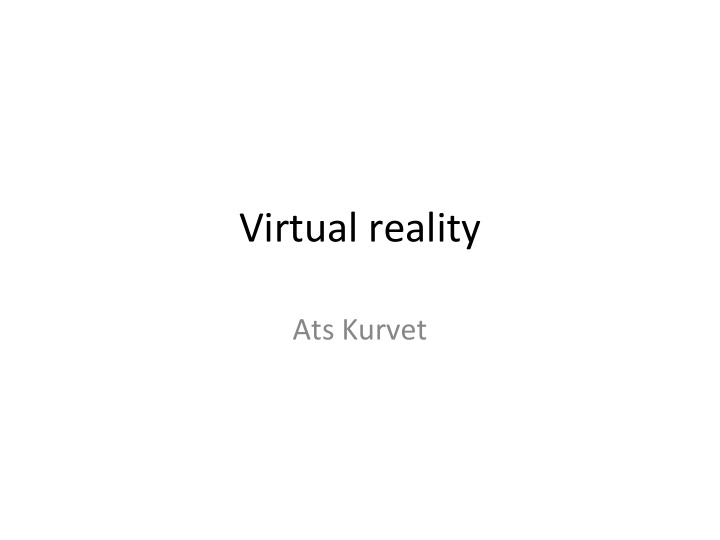



Virtual reality Ats Kurvet
Definition • Virtual Reality — a three dimensional, computer generated simulation in which one can navigate around, interact with, and be immersed in another environment. (John Briggs - The Futurist) • Virtual Reality — the use of computer technology to create the effect of an interactive three- dimensional world in which the objects have a sense of spatial presence. (Steve Bryson - NASA Ames)
Augmented reality https://www.f35.com/about/capabilities/helmet
Presence & perception • Presence is the feeling of really being someplace else. • Different barriers of entry for different people.
Technical requirements for presence • 6 degrees of freedom movement – rotational accuracy < ¼ degrees – Translational accuracy < 1mm – rock –solid tracking • > 90 frames per second – low pixel persistence < 3ms • < 20ms latency – motion-to-photon time • > 1k resolution per eye • > 110 degree field of view • Calibrated, quality optics
http://www.destructoid.com/crescent-bay-gives-me-hope-for-the-consumer-oculus-rift-283475.phtml
Tracking • Inertial Measurement Unit at 1kHz • gyroscope • magnetometer • accelerometer – Can not do absolute tracking • Tracking camera – 60Hz – 19ms latency, 2ms for vision processing – Absolute tracking combined with IMU data and predictions
Low persistence • Rolling shutter – 3ms band of light moving across the screen from right to left – Temporal offset for eyes • Global display would be nice.
Resolution and field of view
Optical distortion correction
Optical distortion correction example
Timewarp • Reproject frame before sending it to the display. Game Draw GPU 17 m s Time Warp Input Pre-rendering Sample Sample (t=5ms) Latency: 17ms – Sample (t=14ms) (t=1ms) 4ms = 3ms Unreal engine integration
Audio • Binaural audio • Oculus licensed RealSpace 3D Audio by Visisonics – Uses head-related transfer function. http://www.neumann.com/? lang=en&id=current_microphones&cid=ku100_description
Input • Unsolved with no clear end goal in sight – Track what and how – Latency – Haptic feedback • Optical vs magnetic vs something else?
Design considerations • Design for what input? • Stairs are bad and other cases of motion sickness. • Sitting experience/limited movement. • Social interaction • Sprites look bad so do normal maps • Performance is at a premium • Design visuals around lower resolution • Uncanny valley • Use real world dimensions
Cave Automatic Virtual Environment
Sources & Extras • http://design.osu.edu/carlson/history/lesson17.html • http://media.steampowered.com/apps/abrashblog/MAbrash%20GDC2013.pdf • https://de45xmedrsdbp.cloudfront.net/Resources/files/UE4-Integration-and-Demos_OC-100270768.pptx • http://doc-ok.org/?p=1057 • http://www.roadtovr.com/what-does-it-look-like-in-the-oculus-rift/
Recommend
More recommend